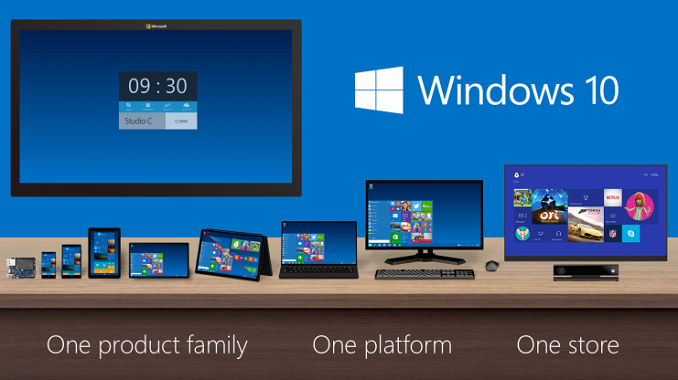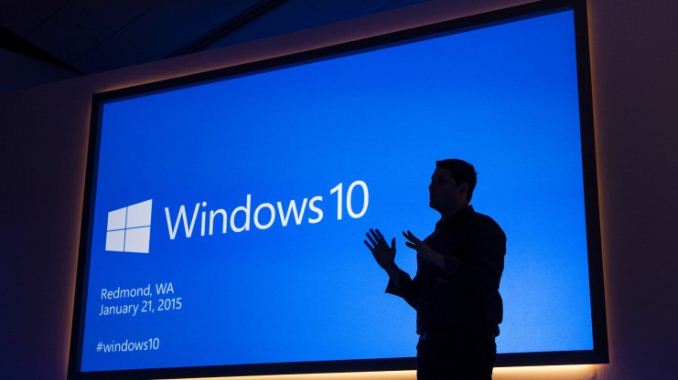Microsoft Announces Free Windows 10 Update
by Brett Howse on January 21, 2015 5:22 PM EST- Posted in
- Operating Systems
- Windows
- Microsoft
- Windows 10

Today Microsoft took the wraps off of their updates to Windows 10, and announced many of the consumer facing features that will be coming with the next version. Likely the biggest announcement of the day came right at the start of the keynote, with a drastic change in the Windows licensing model. There is a lot to discuss, and the keynote itself was over two hours long, so we will cover the rest of the announcements in a separate piece, but due to the significance of this change, it is important to go over the details.
The Windows 10 update will be free for all users of Windows 7 and Windows 8 for one year after launch, which is of course a drastic change over how Windows has been updated in the past. It would be a bit surprising if the free upgrade does not get extended, but for now they are only committing to a free upgrade for a year. However, once updated to Windows 10, the device will kept current and supported over the lifetime of the device. I have already heard “Where is the money going to come from” but really this is sort of a moot point anyway, since the vast majority of people do not pay to upgrade their software anyway. Most of the Windows upgrades come when a person upgrades their device, and at least as far as right now, Windows still has a licensing cost to the OEMs except for some of the smaller, lower cost devices. The initial sale of the device will be the income source, as well as promoting their various online services such as OneDrive, and Office 365, which can bring in subscription based fees. In a way, it is similar to how Apple treats OS X, with the price of the operating system built into the overall system, and then updates can be made available inexpensively going forward.
Really this is about moving the platform forward, and trying to avoid another Windows XP where a large chunk of their user base gets out of sync with the latest versions of software, which causes developers to have to cater to the old platform and not utilize the new features. Windows 7 certainly has the capability of becoming the next Windows XP, so this is an important step if they want developers to build out the new ecosystem.
This is a huge change to Windows, and will move Windows into the realm of being treated as a service. Not only will it move people off of the old platforms much quicker (who does not like free?) it will also allow Microsoft to keep the platform moving forward in the future. The mobile operating systems have already shown how effective this can be, with new APIs and OS features being able to be used by developers much quicker than on the desktop.
This is a key point to moving developers and end users towards the Universal App model, so strategically it makes a lot of sense. If the majority of people are still running a version of Windows that does not support Universal Apps such as Windows 7, it is going to be very difficult to get major developers to build out the platform.
Also, I believe it is also a play towards improving the app situation on Windows Phone. As we will detail in a later piece, Windows Phone is going to be gone, and replaced with just Windows. Windows 10 already has a better mindshare than Windows 8 ever did, so focusing on helping developers build apps that can reach all of their platforms can only help.
Perhaps we now know why Windows 9 was skipped – Windows 10 could be the last major Windows release, with all future versions being an extension of Windows 10.
Source: Microsoft











47 Comments
View All Comments
Taurus229 - Thursday, January 22, 2015 - link
A big question for windows 7 users. If I need to do a complete reformat and reload after 1 year or longer down the road, will I be able to ?????????? Will microsoft allow us to download a copy to a DVD???????????? What is the actual reality after one year????????SilentRunning - Thursday, January 22, 2015 - link
Also, will the license be tied to the device? They refer to the life of the device which implies once converted to 10 it becomes the equivalent of an OEM license.blzd - Friday, January 23, 2015 - link
Have you seen how reformatting works on Windows 8? There is no DVD used, you simply select reformat from within the Windows environment and it does a "system restore" type thing. Basically the same way it has worked on OSX and other platforms.Mississippian - Friday, January 23, 2015 - link
What is the definition of "supported over the lifetime of the device" Is it the lifetime of the device I own as long as it works or is it when the manufacturer no longer provides support. The later is just usually a few years.Coup27 - Friday, January 23, 2015 - link
I presume this means I have to have Windows 7 on my machine to perform the upgrade to Windows 10. I always prefer a clean install of an OS rather than an upgradea) Does this mean if I want to reinstall at a later date I have to install 7 before I can update to 10?
b) what happens if I want to reinstall after the 12 months is over?
Michael Bay - Tuesday, January 27, 2015 - link
I would reinstall 7 right before 10 releases. Then again, once 10 is installed, 7 will go to Windows.OLD as usual, so there may be no need.Considering reinstalling, with 7 and 8 there was a deployment program by MS that copied your license information and allowed to autoactivate on reinstall. I don`t remember the name, though.
Jimmy172 - Friday, January 23, 2015 - link
Does anyone know if the Windows 10 upgrade will work for OEM Win 7 licenses? We use the Volume Licensing Service Center, and I can't even get an upgrade license from Windows7 Home Premium to Pro with out a complete system install, necessitating a complete backup and reinstall of all other software and data.